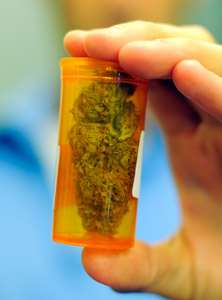However, this disclaimer comes at the very end:
Researchers say their findings should be interpreted cautiously, given that they studied a relatively short period of time and that the margin of error was high. But the study may help inform decisions being made by local and state officials about how to regulate medical marijuana dispensaries.
And from the Los Angeles Times:
The researchers acknowledge that the results are subject to a large margin of error, so the increase in crime within less than a third of a mile could range from as low as 5.4% to as high as 114%.
The East Bay Express provides further caution:
"The study's validity is limited by the length of time studied — just 21 days — and the “noise” in the data. That's because crime on any given block is actually pretty rare, Jacobson said, so tiny changes like one or two incidents can make the numbers look bigger than they are. “The estimated increase should be interpreted with some caution,” the paper states.
Still, even with that potentially wide variation, the fact that crime was found to increase, not decrease, when dispensaries closed is at odds with the view of medical marijuana opponents like the California Police Chiefs Association. The organization's Task Force on Marijuana Dispensaries wrote a 2009 white paper (pdf) that argued the following, in a section called "Ancillary Crimes":
Throughout California, many violent crimes have been committed that can be traced to the proliferation of marijuana dispensaries. These include armed robberies and murders. For example, as far back as 2002, two home occupants were shot in Willits, California in the course of a home invasion robbery targeting medical marijuana.32 And, a series of four armed robberies of a marijuana dispensary in Santa Barbara, California occurred through August 10, 2006, in which thirty dollars and fifteen baggies filled with marijuana on display were taken by force and removed from the premises in the latest holdup. The owner said he failed to report the first three robberies because “medical marijuana is such a controversial issue.”
The report goes on to describe other violent crimes related to medical marijuana, and discusses a money laundering and organized crime connection to boot.
But that evidence is anecdotal. The RAND study's lead author, Mireille Jacobsen, says, the report is "the first systematic, independent analysis” of the claim that dispensaries actually attract crime.
An increase in crime resulting from the sudden lack of a dispensary does seem counter-intuitive. Why might it occur? From the Times again:
The researchers did not try to draw conclusions on why crime increased, but offered the hypothesis that dispensaries may heighten security in the areas around them because they employ cameras and guards, increase late-night foot traffic, replace illicit street sales and draw heavier police patrols.
I asked KQED's Michael Montgomery, who has covered the medical marijuana issue for a long time, what he thought of the study.
"Some opponents of the legalization of medical marijuana have argued that outlets like dispensaries that distribute the product become a magnet for crime," he said. "However, there's never been a lot of data to back up that assertion. So the significance of the RAND study is that we now have serious data arguing just the opposite, that outlets that legally distribute marijuana have not created an increase in crime."
Montgomery also says the report's findings corroborate what he's been told over the years by police officers in San Francisco and Oakland. "They say the establishment of dispensaries has actually led to a decrease in crime. It's true there have been robberies, killings related to dispensary operators, but if you compare that to crime associated with liquor stores, the argument is, it's much lower."
KQED's Mina Kim asked the Los Angeles City Attorney's Office for a response to the RAND study. And surprise: They are not impressed. The email response:
Concerning the City of Los Angeles, the Rand Study is deeply flawed.
The Study is the polar opposite of a scientific and measured response to verified data. It relies exclusively upon faulty assumptions, conjecture, irrelevant data, untested measurements, and incomplete results. The conclusions are therefore highly suspect and unreliable.
For confirmation, simply ask the residents in areas where dispensaries were or are located. In the end, random numbers do not tell the story, people do. Specifically, some of the shortcomings in the Study include the following:
1. The City Attorney sent a cautionary letter to illegal dispensaries on May 4, 2010. The Study considered 10 days before and after June 7, 2010, which was the effective date of the City’s new ordinance.
2. The 10 day time period before and after the June 7, 2010 date assumes without any substantiation that the dispensaries that received the May 4 letter remained open until June 7, closed on that date, and remained closed for 10 days. It is more likely that some closed in May, some re-opened during the interval of the Study, and some did not close at all.
3. The faulty assumption that the dispensaries closed immediately on June 7 and stayed closed for 10 days further fails to take into account the fact that in any period of shutting down, dispensaries will often have fire sales, internal fights among their participants, and offer incentives in order to dispose of their product.
4. Because of the difficulties and fire sale promotions that arise when any business closes, it is quite possible that member in-fighting, increased traffic to the dispensaries for bargains, and disgruntled clientele who found the dispensaries in a state of transition, accounted for the increase in crime in the 10 days following June 7, 2010.
5. It is not credible to suggest that security guards at illegal dispensaries foster a sense of neighborhood safety, as the common practice of security guards at dispensaries is to remain on the dispensary premises, in contrast to security personnel hired by a community who are deliberately dispersed throughout the area.
